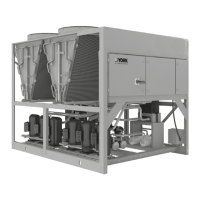JOHNSON CONTROLS
181
FORM 150.72-ICOM7
ISSUE DATE: 10/22/2020
10
SECTION 10 – MAINTENANCE
It is the responsibility of the equipment owner to per-
form maintenance on the system.
Important
If system failure occurs due to improper maintenance
during the warranty period, Johnson Controls will not
be liable for costs incurred to return the system to sat-
isfactory operation. The following is intended only as
a guide and covers only the chiller unit components. It
does not cover other related system components which
may or may not be furnished by Johnson Controls.
System components should be maintained according to
the individual manufacture’s recommendations as their
operation will affect the operation of the chiller.
COMPRESSORS
Oil Level check
The oil level can only be tested when the compressor
is running in stabilized conditions, to ensure that there
is no liquid refrigerant in the lower shell of the com-
pressor. When the compressor is running at stabilized
conditions, the oil level must be between 1/4 and 3/4 in
the oil sight glass. At shutdown, it is acceptable if the
oil level falls to the bottom limit of the oil sight glass.
Use YORK “V” oil when adding oil.
Oil Analysis
The oil used in these compressors is pale yellow in
color (POE oil). If the oil color darkens or exhibits a
change in color, this may be an indication of contami-
nants in the refrigerant system. If this occurs, an oil
sample should be taken and analyzed. If contaminants
are present, the system must be cleaned to prevent
compressor failure.
Never use the scroll compressor to pump
the refrigerant system down into a vacu-
um. Doing so will cause internal arcing
of the compressor motor which will result
in failure of compressor.
CONDENSER FAN MOTORS
Condenser fan motors are permanently lubricated and
require no maintenance.
Condenser MCHX
Dirt should not be allowed to accumulate on the
MCHX condenser surfaces. Cleaning should be as
often as necessary to keep coils clean.
Exercise care when cleaning the MCHX
so that the ns are not damaged.
CONDENSER MCHX CLEANING
The cleaning procedure for the condenser MCHX is
significantly different than tube and fin type MCHX.
Care must be taken to understand the differences to
avoid damage to the MCHX. Adhere to the following:
• Do not use coil cleaners or any chemical on a
MCHX. This can cause severe damage to the
coils.
• Do not use a pressure washer to clean the MCHX.
While it is possible to clean a the MCHX with a
pressure washer, it’s also possible to destroy it.
• Do not contact the MCHX with a hard surface
such as a hose nozzle or metal vacuum nozzle or
any other tool.
To clean the MCHX, complete the following steps:
1. Remove surface debris such as dirt, leaves, in-
sects, and bers, with a vacuum cleaner having
a soft attachment rather than a metal tube. Com-
pressed air blown from the inside out can also be
used. When brushing debris o the face of the
MCHX use a soft bristle (not wire) brush. Do not
scrape the MCHX with the vacuum nozzle, air
nozzle, or any other tool.
2. Rinse the MCHX with tap water. Do not use
MCHX cleaners. Rinse the coil from the inside

